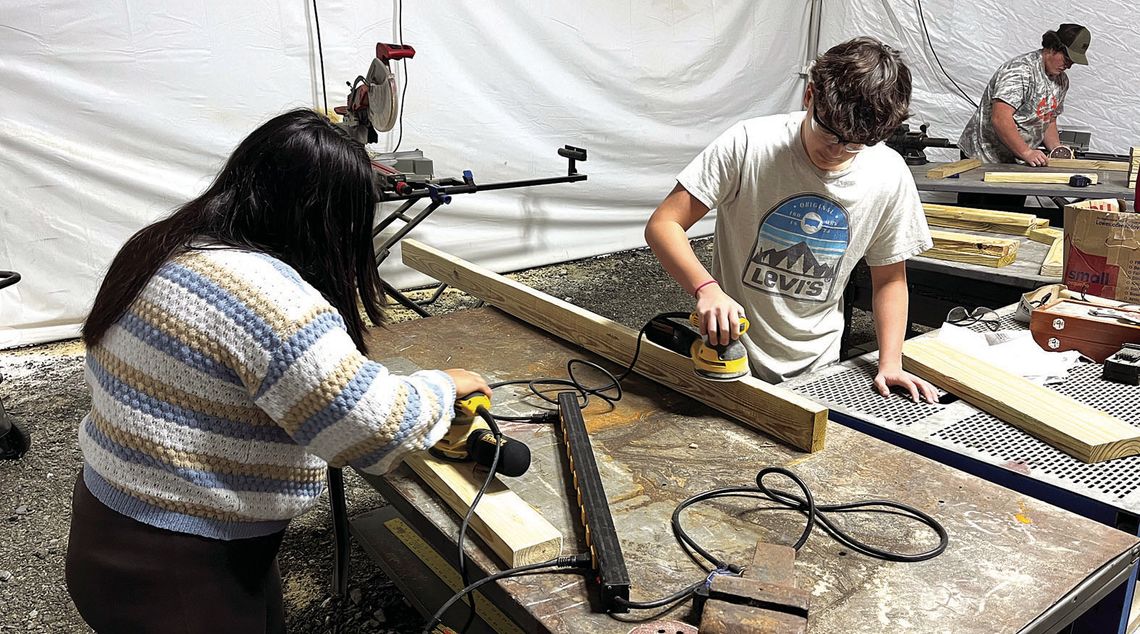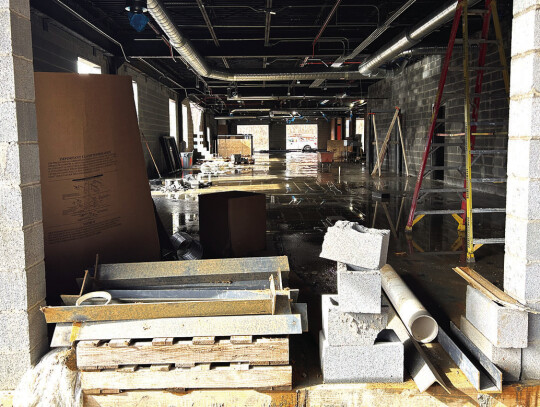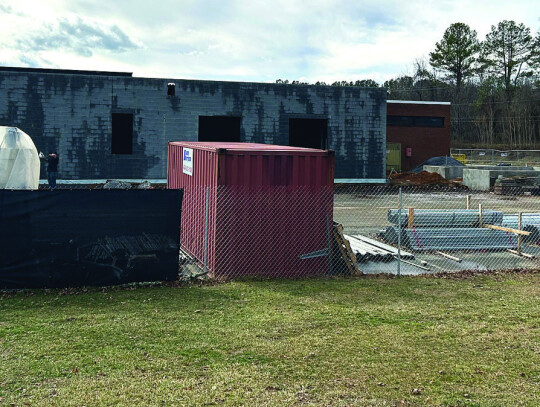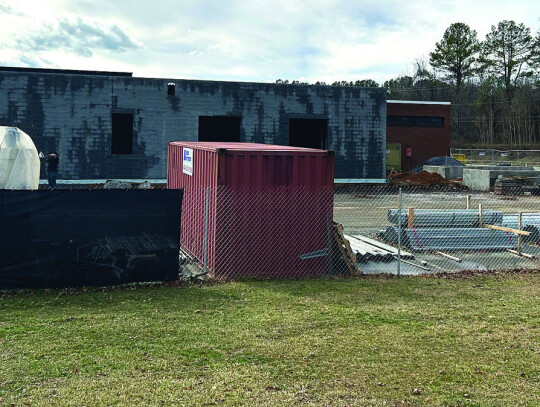With less than a year before its projected opening, work on the Rockbridge Innovation Center, formerly the Floyd S. Kay Technical Center, is going strong.
“We’re right in the middle of everything that’s going on,” said Kurt Bennett, who taught building trades at Rockbridge and is currently managing the renovation. “A lot’s happening all at once, and you’re seeing a lot of changes.”
As of late last month, crews were taking up sections of the parking lot, and making progress on completing the exterior of the building.
“We’ve got some major goals since we’ve got a nice time frame of weather. We’ve got the roof; they’re getting ready to have the roof guys come up. Whatever we’ve got up there now they’re going to seal it up,” said Bennett.
“The brickwork is getting ready to start here probably within the next three weeks. We’re ready to start putting the brick on this thing and getting ready to put the doors in, the exterior doors and windows should be here within about a month and a half,” he said.
More detailed work will happen once the interior is protected from the elements.
“We’ll be able to close this thing up, which is nice to be able to start conditioning it more. Because when we get to March or so, then we start doing more interior finishes, and we’ve got to have more climate control,” Bennett explained.
In spite of January snow, the project has managed to stay on track for its projected completion, in time for students to return for the second half of next school year.
“We are ahead of schedule, slightly ahead of schedule. The projected date for us to move back in is December 2024,” said Bennett.
“They’ve scheduled the work quite well to where they can do a lot more inside work through this time of the year, and that allows for the progress to still progress, at a less inconvenient timeline,” he said.
A ground-breaking ceremony for the innovation center was held last summer, with demolition work beginning in earnest in August. -For this school year, students are making use of temporary structures and creative scheduling.
“We have been able to work around, and outside we have some large tents, that we heat, and we’ve not really had any issues at all with using them as flexible areas,” said Bennett.
“With the classroom time and the classroom instruction, they’ve built it into the schedule throughout the school, so they have their own area to where they can run their classrooms inside,” he said.
“We do have auto body and auto mechanics; they’ve been able to utilize a lot more outside, and we have building trades on the far end with a tent,” he said.
“But the good thing about it is, it’s weather sensitive —we’ve been able to move things around and be able to make it work,” said Bennett. “It’s obviously not the most ideal, but its functional for us, and the students seem to be very receptive to it; instructors are very receptive to it.”
Teachers and administrators have been able to turn to resources outside the school as well, using space at Mountain Gateway Community College for the culinary students and taking others on field trips for additional hands-on experience.
Bennett credits the flexibility and creativity of the teachers for keeping programs running smoothly through their temporary displacement.
“I really do commend the teachers for being extremely creative with what they’re doing,” he said. “They’re not skimping on [student] experience. They’re doing what they can do, and that takes a lot of creativity.” -Teachers have also been called on to provide input on the design of the new innovation center.
“The good thing about our district, they actually had meetings, where the teachers worked with the engineers to say, ‘This is our wish list, this is what we would like to see happen,’” Bennett said.
“You normally don’t see a lot of that. It’s usually, ‘This is what we’ve designed, and now see how you can fit in it.’ They’ve really taken the time to do a lot more investigation,” he said. “I think this is going to take us in a whole new direction. How can we not make it work, how can it work? And I think that that’s the thing that’s probably the most exciting part of it.
“It’s about making sure that what we’re designing is in the best interests of education, because at the end of the day, it’s just a structure without kids in it.”
The design of the new innovation center, built partially from these conversations, has shifted many of the programs from their old locations.
The agriculture program has been moved to the front of the building, where a new greenhouse will soon be erected, and where it will be more easily accessible to the community when students are selling plants or Christmas trees.
For the building trades, a new storage space has been added, which will allow for materials to be brought in and out easily and secured.
A protected area has also been created with an elevated section of roof, so that students and their projects will be protected from the elements.
“This is where our building trades, our house construction, is going to happen,” Bennett explained. “It’s going to see a lot less weather, because it’s under something. Even though it’s so high, it might get a sprinkle here or there, but for the most part, it will keep a lot of that weather off of it.”
The other programs will also have renovated spaces, and, overall, the building redesign will create a more open atmosphere.
“I love all the added natural light too; it just changes things,” Bennett said. “Education has changed, from an institution to something more collaborative — more light, more energy. Instead of trying to create energy, you’re actually starting with it.”
While much will be changing, efforts were made to utilize the existing structure as much as possible.
“If you were to look at the new areas — the new building trades building, the greenhouse, the block on the front — anything that’s block is new. The nice thing about it was that some of it was roofed already,” Bennett explained.
“Everything else was here, so now it’s recutting the holes, and redesigning,” he said.
The design of the original building simplified the current building process.
“The original design, back in 1976 when they built it, they actually set the entire structure in steel, and they then enforced it with block and structure,” said Bennett.
“When they build these, it’s easier to knock a wall out or knock a piece out, as long as you don’t interfere with the framework, the post steel structure.”
Changes will continue as the project moves ahead, with brick soon to be added to new sections of the building, and doors and windows on the way.
.jpg)






